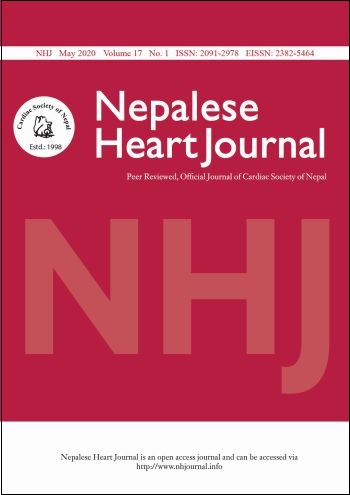Shahid Gangalal National Heart Centre-ST-elevation Myocardial infarction Registry (SGNHC-STEMI-Registry), Nepal
DOI:
https://doi.org/10.3126/njh.v17i1.28795Keywords:
Nepal, Primary PCI, STEMI Registry, ThrombolysisAbstract
Background and Aims: Incidence of ST-elevation myocardial infarction (STEMI) is increasing in Nepal. We aim to describe the presentation, management, complications, and outcomes of patients admitted with a diagnosis of STEMI in Shahid Gangalal National Heart Centre (SGNHC), Nepal.
Methods: Shahid Gangalal National Heart Centre-ST-elevation registry (SGNHC-STEMI) registry was a cross sectional, observational, registry. All the patients who were admitted with the diagnosis of STEMI from January 2018 to December 2018 were included.
Results: In this registry, 1460 patients out of 1486 patients who attended emergency were included. The mean age of patients was 60.8±13.4 years (range: 20 years to 98 years) with 70.3% male patients. Most of the patients (83.2%) were referred from other hospitals and 16.8% of patients directly attended the SGNHC emergency. During the presentation, smoking (54%) was the most common risk factor, followed by hypertension (36.6%), diabetes mellitus (25.3%), and dyslipidemia (7.8%). After admission, new cases of dyslipidemia, HTN, Impaired Fasting Glucose (IFG), and Type 2 DM were diagnosed in 682 (51.3%), 182 (20.1%), 148 (10.3%) and 95 (8.9%) respectively. At the time of presentation, 73.3% were in Killip class I and 26.3% were above Killip class II with 5.1% in cardiogenic shock. Thirty-one percent of the cases received reperfusion therapy (Primary percutaneous intervention in 25.2% and fibrinolysis in 5.8%). Inferior wall MI was the most common type of STEMI. Among the patients who underwent invasive therapy, the multi-vessel disease was noted in 46.2% cases and left main coronary artery involvement in 0.7% cases. In-hospital mortality was 6.2% with cardiogenic shock being the most common cause. Aspirin (97.8%), clopidogrel (96.2%), statin (96.4%), ACEI/ARB (76.8%) and beta-blocker (76.8%) were prescribed during discharge.
Conclusion: The SGNHC-STEMI registry provides valuable information on the overall aspect of STEMI in Nepal. In general, the SGNHC-STEMI registry findings are consistent with other international data.
Downloads
Downloads
Published
How to Cite
Issue
Section
License
This license enables reusers to distribute, remix, adapt, and build upon the material in any medium or format, so long as attribution is given to the creator. The license allows for commercial use.




